NSE 222 W3 QUALITATIVE DATA ANALYSIS AND DATA MANAGEMENT
1/30
There's no tags or description
Looks like no tags are added yet.
Name | Mastery | Learn | Test | Matching | Spaced |
|---|
No study sessions yet.
31 Terms
data collection and analysis pt 2
most commonly data collection and analysis are done concurrently in qualittive research although obviously at least some data needs to be collected prior to analysis
many researchers beleive that the stages of data collection adn data analysis should be integrated, whereas others beleieve that these strategies should be seperate
qualitative data
qualitative researchers gather data from variety of sources, including interviews, observations , narratives adn focus groups
the open nature of qualitative inquiry typically results in the collection of more data than required and is referred to as “fat data”
most researchers wish to use the original words from the participants so that the researchers own interpretations and eprsonal biases are not juxtaposed with the aprticipants thoughts
the presences of the original words allow the reader to check the authenticity of the data
data analysis and data collection
image
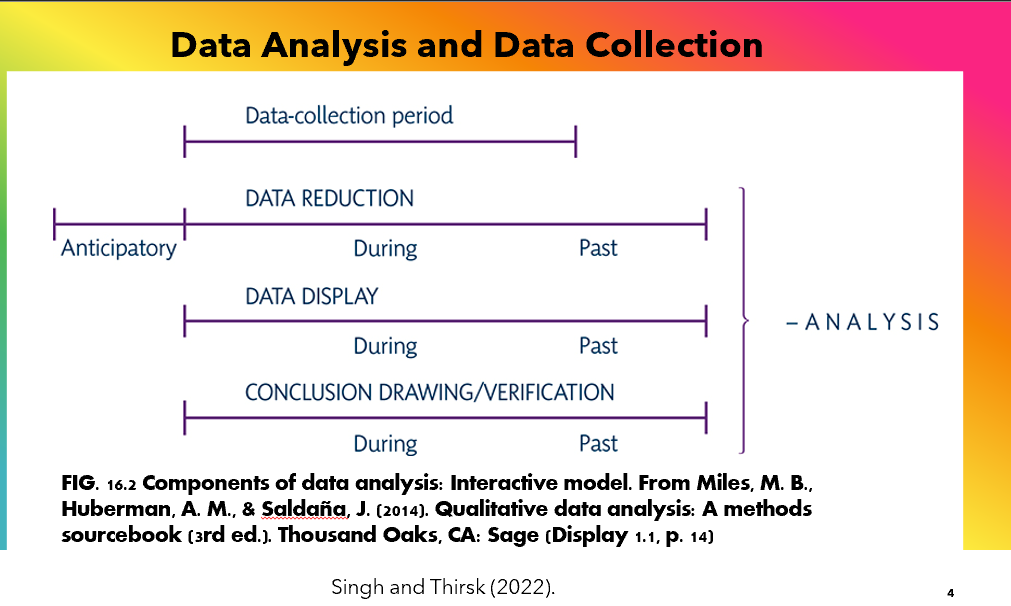
methods of organizing data
Manual methods (kinetic) - labour intensive
useful when amount of data is small
conceptual files
labor intensive
Computer assisted qualitative data analysis software (CAQDAS) - how usually used
faster, can handle large volumes of data
not as hands on as manual sorting
risk of turning cognitive process into a mechanical and technical activity
All data must be backed up and stored in multiple places,
whats data reduction
Ongoing process as data are collected - data saturation when no new emerging/redundancy of themes
Process of selecting, focusing, simplifying, abstracting, and transforming the data
Organized into meaningful clusters (themes or structured meaning units)
Thematic analysis: Process of recognizing and recovering the emergent themes - most freq occuring
Memos are kept to help organize data, write personal notes to self.
Data are coded—given a tag or label according to theme/category.
Codebook is used to organize code into lists.
Researcher immerses self in the data during this stage, often for weeks or months!
data display
An organized, compressed assembly of information that permits conclusion drawing and action
Graphs, flow charts, matrixes, model
Profiles or Vignettes
Narratives or direct quotations - DQ used as much as possible
Must ensure that the presentation supports the findings and relays what needs to be known
whats the computer program for coding
nvivo
coding
considerable variety in the process of coding
steps in coding data:
as sampling , identifying themes, building code books and amrking texts
three types of coding - soem or all types
descriptive - of pt may elicited
, topic - topic/issue
, analytic
researchers use some or all of these types of coding
qualitative data management and organization - coding
Main task to develop system to classify/index material
Requires thorough reading of transcripts to identify underlying ideas, concepts (codes)
Codes can vary in detail and level of abstraction
Data are converted to smaller manageable units and closely examined for patterns and meanings
important concepts are then given a name or label (code)
process of coding
2 Steps:
First Step: Cycle Coding (summarizes chunks of Data)
Second Step: Themes/ pattern codes (occurs after data collection)
The first cycle codes are organized into smaller
categories: themes or constructs during the second step
The coding process itself is analysis (Miles et al., 2014).
questions to ask in developing a coding scheme
what is this
what is going on
what does it stand for
what else is this like
what is this distinct from
coding example image
coding scheme image
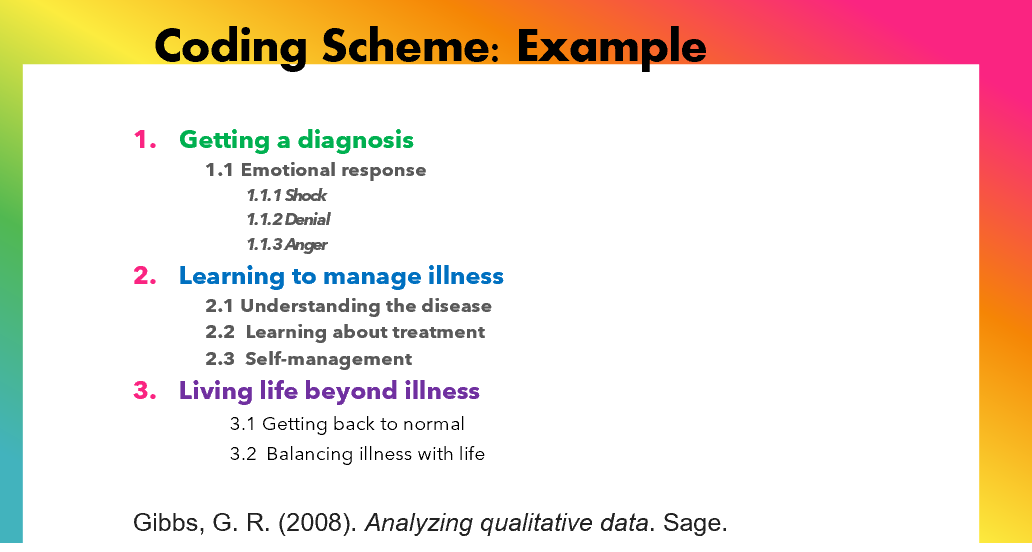
manual coding example
image
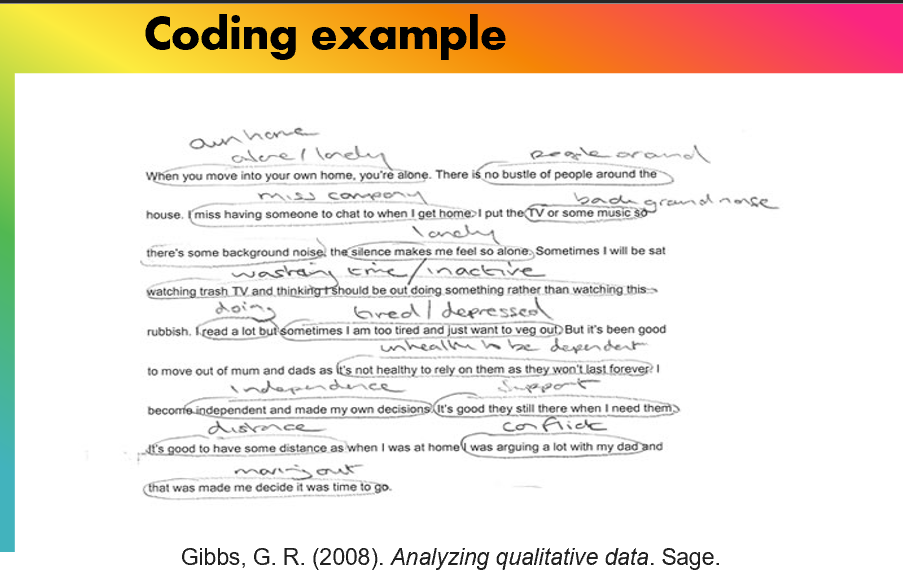
text coding exmaple
image
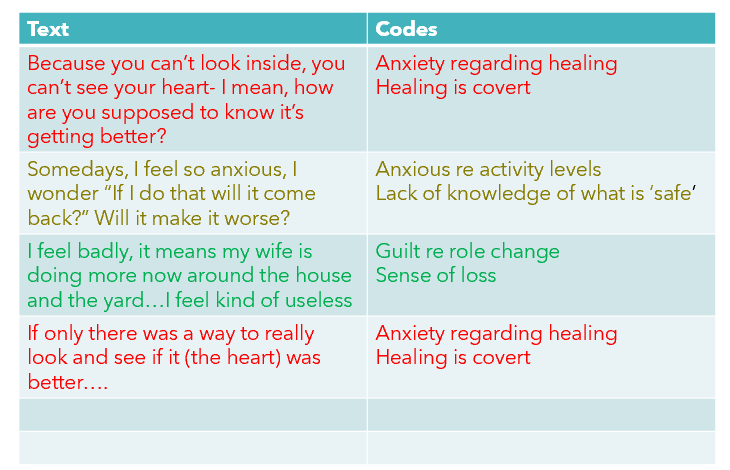
colour coding = cooding example
colour ex
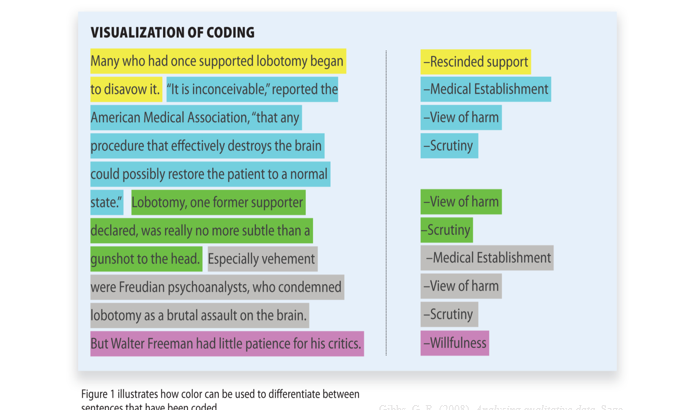
qualitative data management and organization - coding qualitative data
Once codes (categories) are determined, all data are reviewed for content and are “coded” or assigned to appropriate codes categories
May take several readings of material
As coding proceeds researcher often discovers category system was incomplete or inadequate
Necessary to review large portion of data before completing categorization scheme and reread/recode data as required
Narrative materials are usually non linear – paragraphs from interviews may contain elements of several codes/categories
qualitative analysis
Begins with collecting bits of information and piecing them together,
building a mosaic or a picture of the human experience being studied.
When one steps away from the work, the whole picture emerges
Let’s explore how we collect these “bits” of data and make sense of them
qualitative data analysis
The overall goal is to make meaning out of massive amounts of text (data).
The purpose of Data analysis is to answer the research question
Many methods available but in the end each study is unique and is reliant on the creativity, intellect, style and experience of the researcher.
overview of data analysis
When does data collection end and data analysis begin?
qualitative analysis is not a linear process; rather, it is cyclical, transformative, reciprocal, and iterative.
Common features to qualitative data analysis:
Affixing codes or themes to a set of field notes, interview transcripts, or documents
Sorting and shifting though these coded materials to identify similar phrases, relationships between variables, patterns, themes, distinct differences between subgroups, and common sequences
Isolating these patterns and processes, and commonalities and differences, and taking them out to the field in the next wave of data collection
Noting reflections of other remarks in the margins
Gradually elaborating a small set of assertions, propositions, and generalizations that cover the consistencies discerned in the database
Confronting those generalizations with a formalized body of knowledge in the form of constructs or theories
qualitative data analysis - challenges
Qualitative researchers analyze text, not numbers (interview data are usually tape recorded and transcribed [typed up] verbatim prior to analysis)
No universal rules
Labour intensive, complex, creative,
Requires strong inductive skills,
Organizing and making meaning of enormous volumes of narrative data,
Reducing data for reporting
qualitative analysis principles
No standard rules for qualitative analysis
Data management and organization (reductionist)
Transcribing & reviewing data
Developing category scheme
Coding data using the category scheme
Data analysis (constructionist)
Search for patterns/themes in the data
Validation of thematic analysis
Weaving themes together to integrated picture of phenomenon
phases of data analysis
image
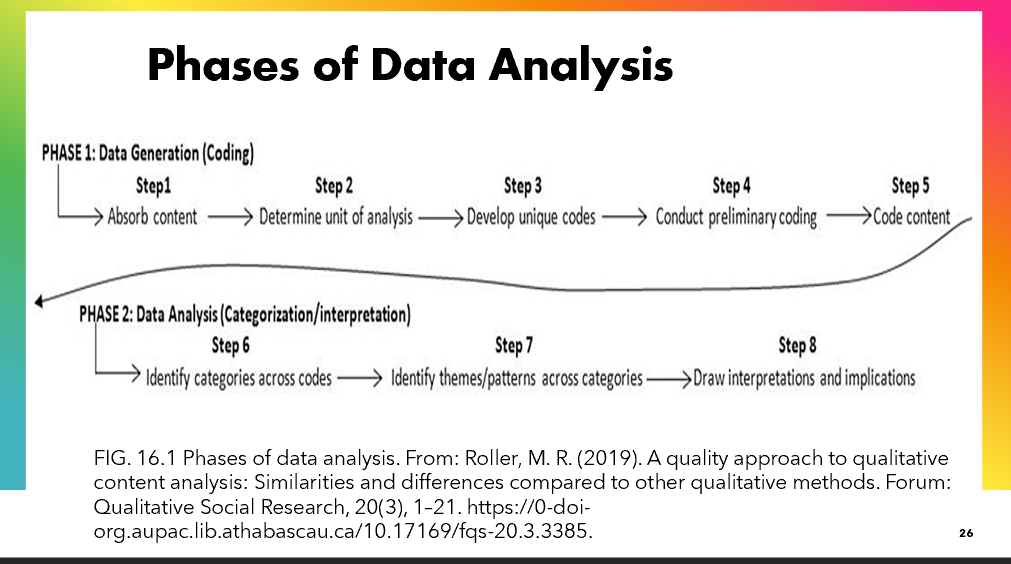
qualitative anlaysis for different research traditions
Each qualitative research approach has its own data analysis process:
Phenomenology
Ethnography
Grounded theory
Participatory action research (Action research
phenomenological analysis
Immersion in the data—read and reread
Extract significant statements.
Determine relationship among themes.
Describe phenomena and themes.
Synthesize themes into a consistent description of phenomenon.
ethnographic analysis
Immerse in the data.
Identify patterns and themes.
Take cultural inventory.
Interpret findings.
Compare findings to the literature.
grounded theory analysis
Examine each line of data line by line.
Divide data into discrete parts.
Compare data for similarities/differences.
Compare data with other data collected, continuously—constant comparative method.
Cluster into categories.
Develop categories.
Determine relationships among categories.
case study analysis
Identify unit of analysis.
Code continuously as data are collected.
Find commonalities, themes.
Analyze field notes.
Review and identify patterns and connections.
analytic procedures
Data management = reductionist
Converting large volumes of data into more manageable segments
Analysis strategies = constructionist
Putting segments together into meaningful patterns
Inductive process
Analysis usually begins with search for themes
conclusion drawing verification
The challenge for the researcher is to stay open to new ideas, themes, and concepts as they appear.
Conclusion drawing is the description of the relationship between the themes.
Verification occurs as the data are collected.
Described as “doing abstraction”
generating meaning
1. Note patterns, themes 11. Intervening variables
2. See plausibility 12. Chain of evidence
3. Clustering 13. Conceptual coherence
4. Make metaphors
5. Counting
6. Contrast/compare
7. Partition variables
8. Subsume particulars
9. Factoring
10. Note relationships
critiquing criteria
Is the method of analysis clear?
Is it appropriate for the study?
Can you follow the analysis step by step?
Is there evidence that the interpretation accurately reflected what was said?
Are credibility, auditability, fittingness, and trustworthiness accounted for?